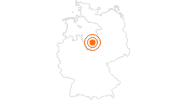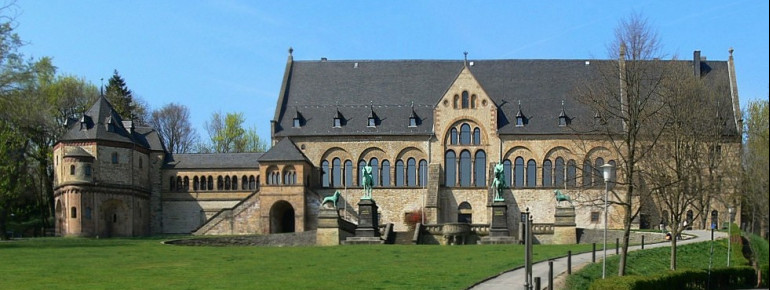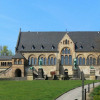Contents
Description
Testimony to medieval splendour
With a length of 54 metres and a two-storey hall building with an arcade corridor on the upper floor, the imperial house is considered the largest preserved secular building of the Middle Ages. After its demolition in 1819, the vestibule of the former "Goslar Cathedral" still remains after its demolition, with its sculptural decoration testifying to the former value of the complex. The former splendour can also be seen in the monumental murals in the hall of the imperial house, which show scenes from German history, fairy tales and legends, or in the artistically decorated throne chair of the first German emperors with its bronze backrests from the 11th century. Today the famous Kaiserstuhl has found its place again in the cathedral vestibule of the Kaiserpfalz, after it had been sold in the 19th century and served Emperor Wilhelm I as a throne at the opening of the first Reichstag of the new German Empire.
To the south of the imperial house is the Palatine Chapel of St. Ulrich, in which, at the request of Henry III, the heart of this emperor, who died in 1056, rests under a tombstone in a gold-plated metal capsule.
Unesco World Heritage since 1992
Since 1992, the Kaiserpfalz, the old town of Goslar and the Rammelsberg mine have been UNESCO World Heritage Sites.
Historical Information
Historical significance of the imperial palace
Early German history was written in the imperial palace in Goslar, from where the great and powerful once determined world politics in the 11th century. It is the birthplace of thirteen kings and emperors, including the later excommunicated Emperor Henry IV.
The imperial palace, together with the imperial house, the cathedral in front of it and two chapels, formed an impressive architectural ensemble.
Origin of the Imperial Splendour Building
The city of Goslar had become rich through the silver deposits of the nearby mine in the Rammeslberg and thus held an important position in the German Empire. This led to Emperor Heinrich II deciding in 1000 to build an imperial palace on this site. The complex was later extended by his successor, Henry III, and in 1050 the imperial house was regarded as the longest secular building of its time. In the 11th and 12th centuries the two-storey hall building with the arcades on the upper floor was built. There was the throne room, which was reserved only for the emperor and his entourage, whereas the lower room was intended for the court people of lower rank. A total of 23 imperial parliaments were held here, the last in 1219. After 1253, when an emperor was present in the imperial palace of Goslar for the last time, the complex slowly began to decay.
Increasing decay
The imperial palace lost more and more of its political importance in the 13th century, and many buildings were destroyed by fire in 1289. In the following years the plant was misused. The chapel served as a prison and the other buildings as a warehouse. Finally, in 1819, the cathedral, which had been dilapidated until then, was demolished, leaving only a vestibule. However, visitors can still imagine its former dimensions today, because the floor plan of the cathedral is embedded in the pavement of the parking lot.
Restoration in the late 19th century
At the end of the 19th century the dilapidated imperial palace was comprehensively restored by the town and the Kaisersaal was painted by the history painter H. Wislicenus to fill the entire wall. His paintings were symbolically intended to create a link between the new German Empire and the medieval Holy Roman Empire of the German Nation. In the course of this reconstruction, a replica of the Braunschweig lion, a symbol of power, and the two equestrian statues in front of the imperial house, representing Frederick I (Barbarossa) and William I, were also created.
Interesting facts
- The day pass at Kaiserpfalz Imperial Palace Goslar is €7.50 making it the cheapest tourist attraction in Lower Saxony.
How to get there
By public transport
Goslar railway station is located on the edge of the historic old town. From there the line 804 of the city bus Goslar takes you to the Kaiserpfalz in about 10 minutes. From the train station Oker the line 802 takes you in half an hour to the Kaiserpfalz in Goslar. However, there is still a small footpath waiting for you, which leads up to the Kaiserpfalz.
By car
from north/west
If you are coming from Hannover via the A7 in the direction of Kassel, leave the A7 in Derneburg and follow the B6 via Salzgitter to Goslar. Another possibility is to leave the A7 a little later at the Rhüden (Harz) exit and take the B82 to Goslar.
from the south
If you are coming via the A7 in the direction of Hannover, leave the A7 at the Seesen exit and take the B248 and B82 to Goslar. There is also the possibility to leave the A7 a little later at the Rhüden (Harz) exit and take the B82 to Goslar.
from the east:
If you are coming via the A2 in the direction of Hanover, change at AK Wolfsburg/Königslutter to the A39 to Braunschweig and leave at AK Braunschweig-Süd. Now you change to the A395 in the direction of Bad Harzburg, which you leave at the exit Goslar and follow the B6 to Goslar.
Parking
At the Kaiserpfalz there are two signposted parking lots: "Kaiserpfalz Nord" and "Kaiserpfalz Süd 1".



